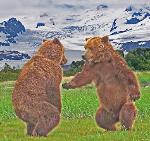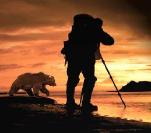How much danger are we in while viewing bears?
Danger is essentially zero when you view from a:
- boat at a site like Wolverine Creek in Alaska
- floating observatory like some used at Knight Inlet in BC.
- high platform – not only might a bear have difficulty climbing to reach you, but bears are very rarely inclined to try. People on
elevated platforms are usually ignored.
No one has ever been injured by a bear while led by a guide certified by the Bear Viewing Association
How commonly are people mauled by a bear?
- Black bears: North America has nearly 1 million black bears. Their habitat is shared with tens of millions of people. Yet,
since 1900, black bears have killed fewer than 60 people – i.e., roughly 1 every other year. They apparently have seriously
injured fewer than 100 – i.e,. about 1 per year. So, on average, your odds of serious injury if you meet a black bear are
infinitesimal, especially if you follow basic safety precautions. There is greater risk of minor injury, but even that risk is
negligible if you are cautious.
- Brown/grizzly bears: North American has roughly 60,000 grizzly/brown bears. Their habitat is shared by millions of people.
Yet, since 1900, they have seriously injured or killed only a few hundred people – i.e., about 3 per year, on average.
Although risk is much higher with a grizzly/brown bear, it is still tiny if you follow reasonable precautions.
- Polar bears: Since 1950, no more than 5-10 people are known to have been killed or seriously mauled by a polar bear.
Uncertainty about the number stems from sketchiness of records through the first half of the 20th century. If a lone hunter
on the sea ice disappears, who is to know whether the person got lost in a blizzard, fell through the ice or was killed by a
bear? Unexplained disappearances have been less likely in recent decades, during which no more than 5 people are
known to have been killed or seriously mauled. One reason that this number is so low is that this continent’s 10,000 polar
bears have historically spent most of their life offshore, on sea ice where they seldom encounter humans – and then
mainly Natives that were alone or in small groups. Furthermore, the number of people sharing polar bear habitat
numbers in the thousands, not millions. Most confrontations occur when polar bears visit Arctic communities, or whale
carcasses that Natives are butchering. The Inuit and Inupiat Native peoples of the North American Arctic are skilled at
coexisting with polar bears – and at killing those they can’t coexist with.
Why do bears sometimes injure people?
Competition: Bears of all species may compete with humans for food or less often for space or dominance.
Food is the most common target of competition.
- Food competition usually occurs when bears are lured close to someone’s home, yard or camp by the odor of groceries,
garbage, or petroleum products (e.g., AvGas or plastic). If a bear finds a treat that is unattended, it may claim the treat, then
defend it against any human who happens by. Or, if the treat is attended by a human, the bear may try driving the person
away so that it can claim the treat. In these cases, risk of mauling tends to be lowest with black bears, then progressively
higher with polar bears, coastal brown bears, and interior grizzly bears.
- Space competition usually occurs when humans visit bear country and crowd too close to a bear – for instance a bear that
does not retreat from the intruders. This is most common where the bear declines to abandon a site where it is fishing or
feeding on the carcass of a large mammal such as a moose, seal or whale. A person might want to fish at that same spot;
or the person might want close up photos of the bear or with it.
- Dominance rivalry: When bears confront one another over food or space, this is linked to rank competition. Rank
determines which bear abandons the resource in favor of its rival. When two strangers encounter one another, for instance
when they approach from opposite directions along a trail, they may either pass one another politely; or they might threaten
one another or even fight for a few seconds to determine who has right of way. Humans encountered on a trail may be
treated the same way: given an opportunity to politely pass by, or to fight. Bears rarely harm people during such
encounters. In fact, it is mainly subadults that try dominating humans. Not only are subadults (like human teenagers) very
eager to test themselves against opponents, but humans are more likely to stand up to subadults than to adults.
Predation: Bears seldom attempt to prey on humans.
- Polar bears: are suspected of being most predatory on people because they are the most predatory on other mammals.
That is, polar bears eat almost nothing except the meat of large mammals – nearly all of which are marine mammals.
However, since 1900, only 2 people are known to have been killed and eaten by a polar bear.
- Black bears: almost never kill anyone to protect themselves or their cubs, or in competition with people over food or other
resources. Rather, on the rare occasions when a black bear does kill someone, it was likely trying to kill and eat the
person.
- Grizzly/brown bears: On a per-bear basis, grizzly/brown bears are about twice as likely as a black bear to trying preying on
someone – where as they are hundreds of times more likely to violently defend themselves or their cubs.
Anti-predator protection:
Bears – especially mothers with cubs to protect – tend to treat people like predators, which is essentially what
sport-hunters are. However, bears that spend time around benign people can learn to trust us.
Anti-predator protection is most likely to be triggered when a person crowds a bear too closely or surprises it at
close range. Bears of all species usually protect themselves by hiding from us or by running away. However,
they occasionally resort to violence.
- Black bears: protecting themselves or their cubs seldom inflict more than minor injuries, comparable to those inflicted by
dogs.
- Coastal brown bears: are more likely to protect themselves violently. Because they tend to be much bigger and strong
than black bears, they tend to do more damage.
- Grizzly bears: tend to be fiercer than their coastal cousins. They are the most likely of bears to protect themselves violently,
and are the leading culprits in serious or fatal bear maulings.
- Polar bears: have apparently not killed anyone while defending themselves or their cubs. If they have seriously injured
anyone, it was probably someone hunting them.
How common are minor injuries?
These occur mainly when someone tries to feed a bear by hand or to touch it.
Are grizzly/brown bears fiercer than black bears?
Compared to a black bear, a grizzly/brown bear is about 2X as likely to be predatory, and several times as likely to be violently
competitive, and hundreds of times more likely to be violently protective. However, with proper precautions, even brown bears can
be safely viewed at photographic distances (e.g. under 100 yards). There are very few circumstances where you could safely view
a grizzly from closer than a few hundred yards.
How much danger are people in while hiking, fishing, camping or hunting?
- Proper precautions can minimize risk of encountering a bear during each of those activities.
- With proper techniques you can minimize risk of being injured when you do encounter a bear.
How can I minimize my risk during an encounter?
- Novices: Remain within arm’s length of at least 5 other people. Remain calm. Do nothing to provoke the bear. View with
a guide certified by the Bear Viewing Association and follow the guide’s advice.
- Guides: Obtain certification from the Bear Viewing Association. If your skills and knowledge have important gaps, training
materials and in-field training are available at nominal cost.
- Other people likely to encounter a bear: Earn a Bear Secure certificate from the Bear Viewing Association. If your skills and
knowledge have important gaps, training materials and in-field training are available at nominal cost.
Should I carry a gun in bear country? What kind? How should I use it?
- A gun is needed only during an emergency – for instance if a bear is likely to attack or has begun.
- It is very hard to kill an attacking bear before it mauls someone. So master shooting skills before you venture into bear
country. Anyone who has not mastered these skills and cannot handle an appropriate weapon should instead rely on
pepper spray or another deterrent.
- Weapon and ammo suitable for killing a bear. In most emergencies you would shoot from under 50 yards. At those
distances, a 12 gauge shotgun with rifled sabot slugs is your best choice of weapon. Only the largest pistols tend to be
effective, and even then effectiveness is usually poor. Pistol bullets tend not to penetrate deeply enough, with enough force
to cripple or kill a bear, and they are harder to aim.
- Vital targets: Learn the spots on a bear’s body to aim for to kill (heart, lungs, spine) or cripple (shoulder, lower spine,
pelvis, upper arms).
- Wounding: If you just wound the bear, it may inflict more injury than if you had not done so. People who shoot bears end
up badly mauled about half the time.
- Do not shoot your partner and leave him/her for the bear.
How effective is pepper spray?
- People who blast a bear with pepper spray are almost never injured by the bear.
- Grizzly/brown bears are more repelled than black bears.
- For people not skilled and equipped with a proper firearm and ammo – including most women and nearly all children –
spray is more reliable than a gun.
- Even experts with a firearm tend to set the firearm down when not guarding or hiking. Spray can be carried on your person
even more conveniently than a pistol, and tends to be far more effective.
For further information on bear safety click here: ALASKA MAGNUM BEAR SAFETY MANUAL
|

